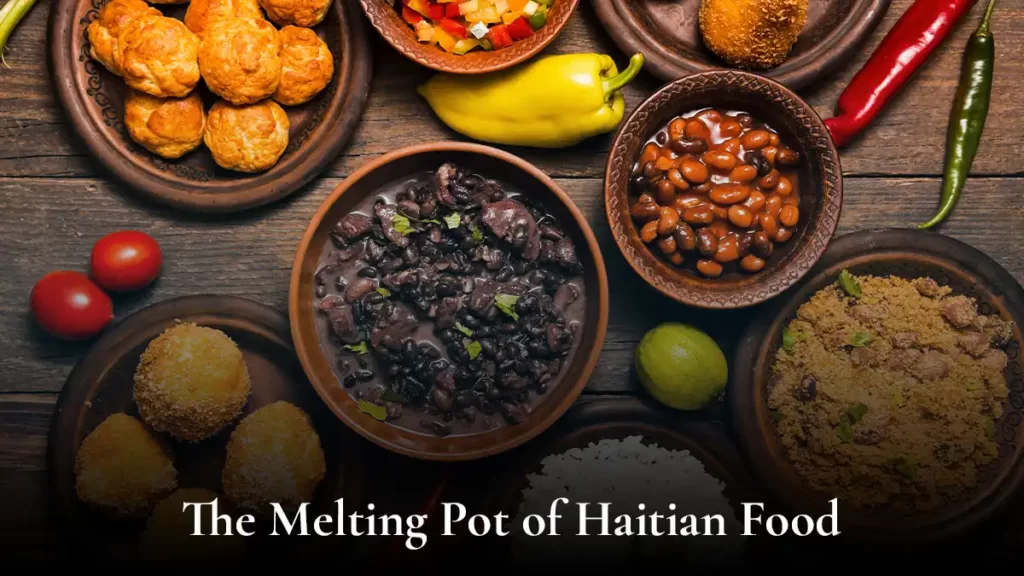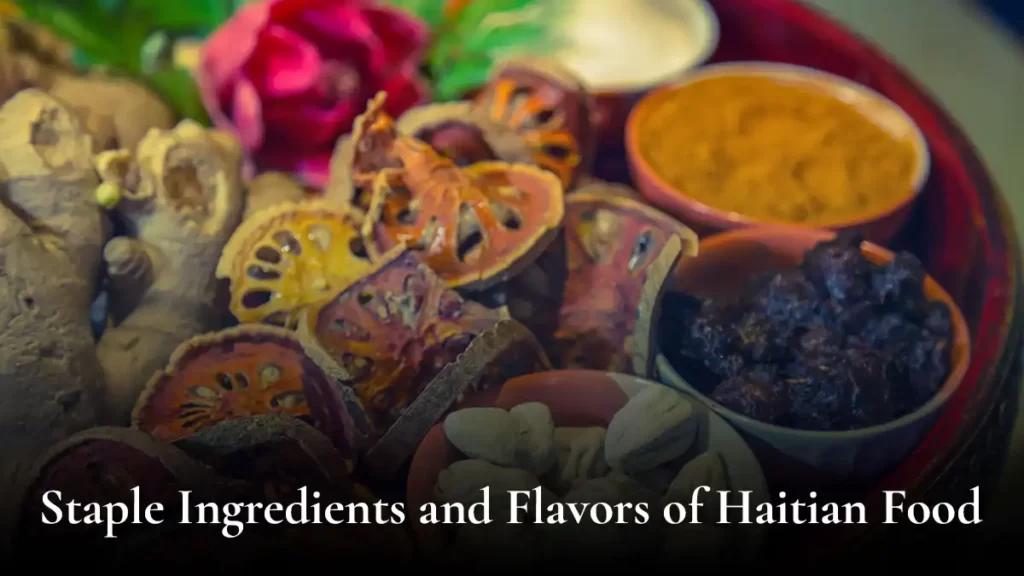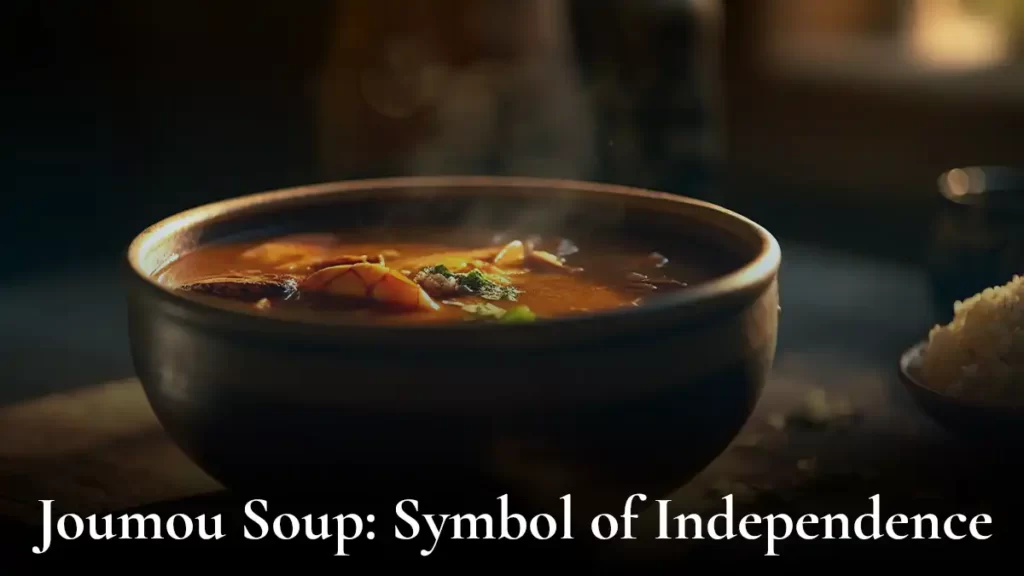Haitian cuisine is a celebration of flavors, history, and tradition. It reflects the diverse influences that have shaped the island nation’s culinary landscape. Haitian food offers a tantalizing journey for the senses, from aromatic spices to tropical fruits. This comprehensive guide takes you on an exploration of Haitian food. It delves into its diverse dishes, cultural significance, and culinary traditions.
The Melting Pot of Haitian Food:


Haitian cuisine is a vibrant fusion of African, French, Spanish, and Indigenous Taino culinary traditions. This fusion of influences has resulted in diverse dishes reflecting the island nation’s rich cultural heritage.
Staple Ingredients and Flavors of Haitian food:


Key ingredients in Haitian cuisine include rice, beans, plantains, yams, cassava, and various tropical fruits like mangoes, pineapples, and coconuts. Spices like cloves, thyme, and scotch bonnet peppers add depth and complexity to Haitian dishes.
Iconic Haitian Dishes:
1) Griot: Crispy Pork Delight


Griot is a beloved Haitian food featuring marinated pork chunks fried until crispy and served with pikliz, a spicy pickled vegetable relish.
- Griot is one of the most beloved and iconic dishes in Haitian cuisine, admired for its crisp exterior and succulent interior. This flavorful delicacy holds a special place in Haitian culinary culture. It embodies the island nation’s rich heritage and culinary traditions.
- At its core, the Griot consists of marinated pork chunks seasoned with a blend of aromatic spices. The spices include garlic, thyme, and scotch bonnet peppers. Then, traditional marination of the pork takes place overnight, allowing the flavors to meld and infuse into the meat.
- The magic of Griot lies in its cooking method, which involves frying the marinated pork until it achieves a crispy, golden-brown exterior. At the same time, it retains its tender and juicy interior. This perfect balance of textures sets Griot apart and makes it a true delight for the senses.
- Serving of Griot often happens alongside pikliz, a spicy pickled vegetable relish that adds a tangy kick to each mouthful. Combining crispy Griot and zesty pikliz creates a harmonious flavor profile that keeps diners returning for more.
- In Haitian households and restaurants alike, Griot is a staple dish enjoyed on special occasions, family gatherings, and festive celebrations. It symbolizes warmth, hospitality, and the joy of communal dining. It brings people together to share the pleasures of good food and company.
- Beyond its delectable taste, Griot also holds cultural significance in Haitian society. It is a dish deeply rooted in the country’s history. Griot reflects the resilience and resourcefulness of its people in the face of adversity.
- Historically, Griot was a dish reserved for special occasions and celebrations, such as weddings, holidays, and religious ceremonies. Its preparation and consumption were steeped in tradition, with families passing down recipes and cooking techniques from generation to generation.
- Today, Griot continues to hold a prominent place in Haitian culinary culture. It is famous not only in Haiti but also in Haitian communities worldwide. Its popularity has transcended borders, earning recognition and acclaim on the global culinary stage.
In conclusion, Griot stands as a shining example of Haitian culinary excellence. It embodies the flavors, history, and traditions of the island nation. The Griot is more than just a dish with its crispy exterior, succulent interior, and bold flavors. It is a symbol of Haitian identity, unity, and pride. Whether enjoyed at home with family or in a restaurant with friends, Griot remains a cherished and iconic dish. It continues to captivate the hearts and palates of food enthusiasts worldwide.
2) Joumou Soup: Symbol of Independence


Joumou soup is a traditional Haitian food enjoyed on New Year’s Day, commemorating Haiti’s independence. It symbolizes freedom and resilience and is made with pumpkin, beef, vegetables, and spices.
- Joumou soup, a traditional Haitian dish, is more than a culinary delight. It embodies a significant historical and cultural narrative rooted in Haiti’s struggle for independence. The soup holds a revered place in Haitian culinary tradition. It symbolizes freedom, resilience, and the triumph of the human spirit.
- At its core, joumou soup is a hearty and aromatic pumpkin soup. It is enriched with various flavors and ingredients that reflect Haiti’s diverse culinary heritage. Its preparation involves simmering pumpkin chunks with tender pieces of beef, vegetables, aromatic spices, and herbs until they meld into a savory and satisfying concoction.
- Joumou soup holds particular significance in Haitian culture as it is traditionally enjoyed on January 1st. It commemorates the country’s historic Independence Day. Its consumption on this auspicious occasion is a symbolic tribute to the indomitable spirit of the Haitian people. People reminisce about their hard-won freedom from colonial oppression while eating it.
- The origins of joumou soup date back to Haiti’s revolutionary era in the early 19th century. Then, the enslaved Haitian population successfully revolted against French colonial rule. Ultimately, they established Haiti as the first independent black republic in the Western Hemisphere.
- During the colonial period, customs forbade enslaved Africans from consuming joumou, a delicacy reserved exclusively for their French masters. However, on January 1st, 1804, following Haiti’s liberation from colonial bondage, the newly emancipated Haitians defiantly embraced joumou soup. It was a symbol of their newfound freedom and equality.
- The consumption of joumou soup on Haitian Independence Day is steeped in symbolism. It represents a rejection of oppression and a celebration of sovereignty and self-determination. It serves as a powerful reminder of Haiti’s revolutionary legacy and the enduring spirit of its people.
- Beyond its historical significance, joumou soup holds a special place in Haitian culinary culture. It is cherished for its rich flavors, nourishing qualities, and communal significance. Its preparation and sharing among family and friends foster a sense of unity, solidarity, and shared heritage.
- Joumou soup’s enduring popularity extends beyond Haiti’s borders, captivating food enthusiasts worldwide. It earns recognition as a quintessential Haitian dish. Its flavorful blend of ingredients and symbolic resonance make it a unique and treasured culinary treasure.
In conclusion, joumou soup transcends its status as a mere culinary creation. It is a poignant symbol of Haiti’s journey towards independence and resilience in adversity. Each spoonful commemorates the triumph of the human spirit and the enduring legacy of freedom that defines Haiti’s rich cultural heritage.
3) Accra: Flavorful Fritters


Accra are savory fritters made from a batter of black-eyed peas, spices, and herbs. These crispy delights are a popular street food enjoyed throughout Haiti.
Accra is a beloved Haitian dish that tantalizes taste buds with its crispy exterior and savory interior. This flavorful delight is a staple in Haitian cuisine, celebrated for its simplicity yet depth of flavor.
- At its essence, Accra is a type of fritter made from a batter of black-eyed peas, herbs, spices, and sometimes seafood or vegetables. People season the batter with garlic, parsley, scallions, and thyme. It gives Accra its distinct Haitian flavor profile.
- The preparation of Accra involves blending the ingredients into a thick batter, which is then deep-fried until golden brown and crispy. The result is a delightful morsel with a crunchy texture on the outside and a soft, flavorful center.
- People commonly enjoy Accra as a snack or appetizer in Haiti, often served hot and fresh from the fryer. Its irresistible aroma and savory taste make it a popular choice among Haitians and visitors alike. You can always enjoy it at home, at street vendors, or at local eateries.
- One of the charms of Accra lies in its versatility, as you can make it with various ingredients to suit different preferences and dietary restrictions. Some versions of Accra feature shredded codfish, shrimp, or vegetables, adding layers of complexity to its flavor profile.
- Accra holds a special place in Haitian culinary culture. It serves as a symbol of comfort, hospitality, and communal dining. People often prepare and share it during social gatherings, celebrations, and festive occasions. It brings people together to savor its delectable taste.
- The history of Accra traces back to Haiti’s diverse cultural influences. It blends African, French, and Indigenous Taino culinary traditions. Its name is believed to derive from the Akan people of West Africa. They have their version of fritters known as “akara.”
- Over the years, Accra has evolved and adapted to reflect Haitian society’s changing tastes and preferences. Today, it remains a beloved and iconic dish that continues captivating food enthusiasts in Haiti and beyond.
In conclusion, Accra embodies the essence of Haitian cuisine. It is flavorful, comforting, and deeply rooted in tradition. Its crispy exterior, savory interior, and cultural significance make it a true gem of Haitian culinary heritage. Generations cherish and celebrate it for its timeless appeal.
4) Tasso Kabrit: Succulent Goat Meat


Tasso kabrit is a flavorful Haitian dish featuring marinated and stewed goat meat. It gets seasoned with a blend of spices and served with rice and beans.
Tasso Kabrit is a beloved dish in Haitian cuisine. Its succulent flavors and rich aromas offer a tantalizing journey for the taste buds. This traditional Haitian delicacy highlights the island nation’s diverse culinary heritage and the artistry of its gastronomic traditions.
- At its heart, Tasso Kabrit features tender goat meat, marinated and stewed to perfection with a symphony of aromatic spices and herbs. The dish captures the essence of Haitian cuisine. It combines bold flavors with tender textures to create an unforgettable dining experience.
- The preparation of Tasso Kabrit begins with marinating the goat meat in a flavorful blend of ingredients. The ingredients include garlic, onions, thyme, scotch bonnet peppers, and citrus juices. This marinade infuses the meat with layers of complex flavors and ensures a tender and succulent result.
- Once marinated, the goat meat is slow-cooked to perfection. It allows the flavors to meld together and the meat to become tender and juicy. The slow cooking process ensures that the meat is infused with the rich flavors of the marinade. It creates a dish that is bursting with taste.
- People often serve Tasso Kabrit alongside traditional Haitian sides such as rice and beans, fried plantains, or pikliz, a spicy pickled vegetable relish. The combination of flavors and textures creates a harmonious balance that delights the palate and satisfies the senses.
- Beyond its delicious taste, Tasso Kabrit holds cultural significance in Haitian society. It symbolizes community, celebration, and the joys of shared meals. Hosts often serve it at special occasions, family gatherings, and festive celebrations. It brings people together to savor its exquisite flavors.
- The history of Tasso Kabrit traces back to Haiti’s diverse culinary influences. It blends African, French, and Indigenous Taino culinary traditions. Its preparation reflects the ingenuity and resourcefulness of Haitian cooks. They have perfected the art of transforming humble ingredients into culinary masterpieces.
- Today, Tasso Kabrit remains a cherished dish in Haitian cuisine, celebrated for its rich flavors, cultural significance, and timeless appeal. One can enjoy it at home with family or at a local restaurant. Tasso Kabrit continues to captivate the hearts and palates of food enthusiasts worldwide.
In conclusion, Tasso Kabrit is more than just a dish. It is a celebration of Haitian culinary artistry, tradition, and heritage. Its succulent flavors and rich aromas pay homage to the vibrant spirit of Haitian cuisine. It invites diners on a flavorful journey that celebrates the richness and diversity of Haitian food.
5) Pikliz: Spicy Pickled Vegetables


Pikliz is a Haitian condiment made from shredded cabbage, carrots, peppers, and onions marinated in vinegar and spices. It adds a tangy kick to various dishes.
- Pikliz, a staple in Haitian cuisine, is a fiery and flavorful condiment that adds a punch to any dish. Pikliz is a delightful blend of crunchy textures and bold flavors made primarily from shredded cabbage, carrots, onions, and scotch bonnet peppers.
- Its preparation involves marinating the vegetables in vinegar, lime juice, and spices like cloves, garlic, and thyme. The longer Pikliz sits, the more its flavors meld together. This creates a tantalizingly tangy and spicy profile.
- Haitians often serve Pikliz alongside traditional dishes like Griot (fried pork), tassot (fried goat), and fried fish. The versatility of Pikliz extends beyond meats. It pairs wonderfully with rice, beans, and even sandwiches. Its vibrant colors and robust aroma make Pikliz not only a condiment but also a feast for the senses.
- The heat from the scotch bonnet peppers gives Pikliz its signature kick. However, this can vary in intensity depending on personal preference.
- For those who appreciate a milder flavor, removing the seeds and membranes from the peppers can help temper the heat.
- Pikliz is more than just a condiment. It’s a cultural emblem that reflects Haiti’s rich culinary heritage. In Haitian households, Pikliz is often homemade, with each family adding its unique twist to the recipe.
- The process of making Pikliz is a labor of love. Carefully select the ingredients and prepare to achieve the perfect balance of flavors.
- Its tangy and spicy profile serves as a reminder of the resilience and vibrancy of Haitian culture. Whether enjoyed at a bustling market or a family dinner table, Pikliz brings people together through its shared appreciation for bold flavors. Its popularity has transcended borders. It captivates the palates of food enthusiasts worldwide who seek adventurous culinary experiences.
In essence, Pikliz isn’t just a condiment. It’s a symbol of Haitian ingenuity and the power of food to unite communities across continents.
Culinary Influences and Historical Significance:


Haitian cuisine bears the imprint of its tumultuous history, with influences from African, French, Spanish, and Indigenous Taino culinary traditions. Blending these diverse influences has created a unique and vibrant culinary tapestry.
The Importance of Food in Haitian Culture:


Food holds immense cultural significance in Haitian society. It serves as a symbol of hospitality, community, and identity. Mealtime gatherings are cherished occasions for families and friends to share traditional dishes.
Haitian Street Food: A Gastronomic Adventure:


Haiti’s bustling streets are full of tantalizing street food offerings, from fried plantains and Griot to akra and pate kode. Exploring Haitian street food is a culinary adventure not to be missed.
Sustainability and Future of Haitian Food:
As Haiti faces environmental challenges and economic hardships, there is a growing focus on sustainable agriculture and culinary preservation. Promoting local ingredients and traditional cooking methods is essential for preserving Haiti’s culinary heritage.
Conclusion: Embracing the Diversity of Haitian Food


In conclusion, Haitian food is a vibrant tapestry of flavors, history, and tradition. It features iconic dishes like Griot and joumou soup and the bustling street food scene. Haitian gastronomy offers a rich and diverse culinary experience. By embracing the diversity of Haitian food, we honor its cultural heritage and celebrate the enduring spirit of the Haitian people.


Leave a Reply